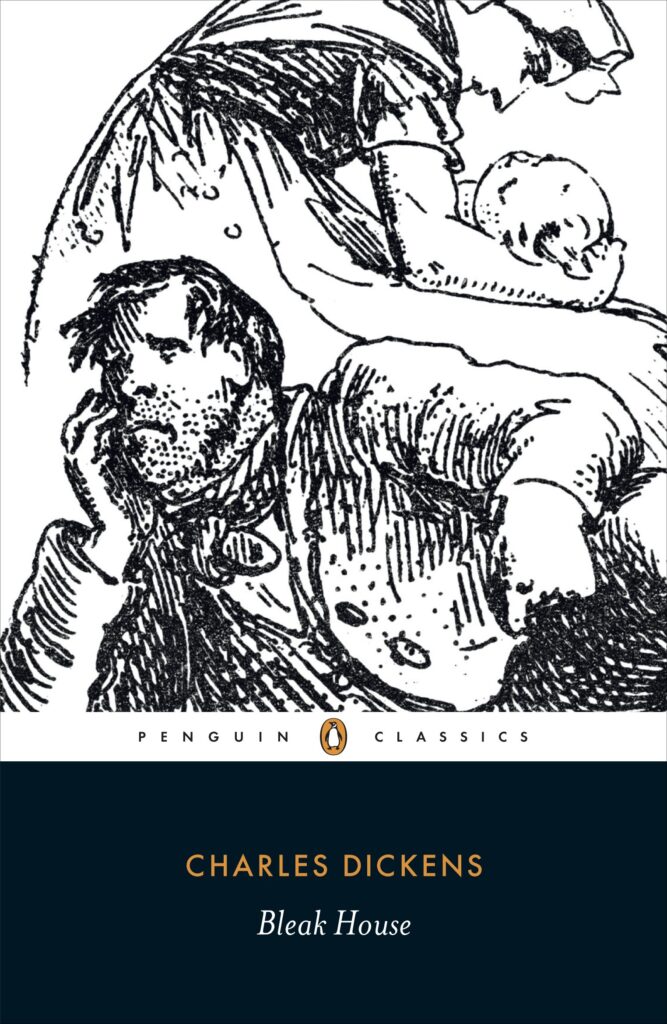
This is one of the Charles Dickens books which is, perhaps, not quite so well remembered. I don’t think it’s entered popular culture quite as much as A Christmas Carol or Oliver Twist, for example – I certainly went into it without even the slightest notion of what the book might be about.
As it happens, it’s a storyline which can’t be summarised very easily. At it’s heart, it’s about a lawsuit which has been going on for years about a disputed will. It’s also about a young woman named Esther Summerson, who comes from a poor background and has been raised by a neglectful aunt. John Jarndyce, who is at the heart of the ongoing case, ends up as her guardian and her life changes significantly (and for the better). This portion of the story is told in the first person from Esther’s perspective – this was probably my favourite thread of the story, as I quite liked Esther’s ‘voice’. Meanwhile, another thread of the story concerns Sir and Lady Dedlock, a rich couple hoping for a payout from the ongoing court case. The chapters about the Dedlock family are told from a third-person perspective. If I’m completely honest, I found it quite complicated and difficult to keep track of all of these aspects of the story – particularly as I don’t know anything about the nineteenth century English legal system! There were definitely a few times throughout the book where I felt quite lost as to what was actually going on.
The summary I’ve given there is also a huge simplification. There are loads of characters, who all have their own storylines as well. There’s Ada, who works alongside Esther, becoming her friend and Richard, who Ada has a romance with and who has various career difficulties of his own. There’s also the bizarre man, Harold Skimpole, who is perpetually in debt, because he spends recklessly and has to borrow from people all the time – in his own words, he has the mind of a child, so cannot be held responsible. There’s Mrs. Jellyby, who dedicates her whole life to charity work (thinking it virtuous), but who is pretty toxic towards the people in her own life. Plus, there’s a homeless boy called Jo, who is essentially used by different characters to their own ends and has quite an unfortunate life. This is just a handful of the most memorable characters, but there are tonnes more of them.
On the positive side of things, I enjoyed Dickens’ usual sense of humour. There are lots of ridiculous characters who are there to send up the government or courts and they made me laugh a few times. There’s also his characteristic critique of the poverty in the country, which was good to see. As it all started to come together and I was finally able to start making some sense of it, I was pleasantly surprised by some of the twists and plot developments. There are definitely some good ideas in this book, wrapped up in funny one-liners and comedic names for the characters. Also, at one point someone randomly dies from spontaneous human combustion – crazy. You never know what’s going to happen next.
On the downside, the book is really long with each individual chapter taking me a very long time to read. A product of the time, the book is very wordy, which certainly doesn’t help when the plot is already extremely complex. Sometimes I’d start a chapter and it would take me quite a while to figure out what was happening – especially with it switching between one first person narrative and another third person narrative. It took me quite some time to realise how these two thing were connected. With so many characters, it also became hard to remember who was who and what everybody was doing at any given point.
So, sadly, this isn’t a book I can recommend. I do like Dickens and have a lot of respect for the things that he stood for, but overall, it was a very complicated one to process and one which ties in heavily to its historic context, making it less appealing to the modern readers. If you want to give Charles Dickens a try, this isn’t the book to read.
Rating: 5.2/10
